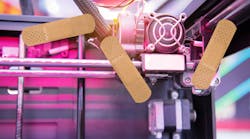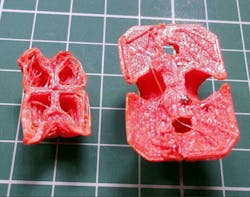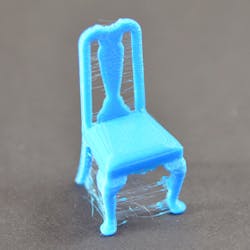The 3 Most Common 3D Printer Problems—and How to Fix Them
Sometimes there isn’t the time or money to call in the experts. The 3D printer has to be back up and running ASAP. Here are some guidelines for just such situations. There’s no guarantee they will work—there may be other problems—but what have you got to lose?
If the first layer doesn`t attach properly, the entire 2D-printed object could be ruined.
Layer fails to attach. Everything was all set to go, and then the 3D printer’s output decided not to attach properly to the surface being printing on. This is probably the most common problem faced by 3D printer users.
This first layer is, of course, what binds the rest of the printing process, so once it fails, almost none of the job will print to specifications and will probably warp. That’s why it’s so important to spot the problem and correct it quickly. There might be several reasons for the failure, but the most likely is that the printer was not levelled. This can cause initial problems with adhesion but also warp the printed object.
“Start by adjusting your bed temperature and keeping it at a high enough temperature to prevent the plastic from cooling down and curling, as it tends to do when contracting,” explains William Gibbons, a tech blogger at Stateofwriting and Ukwritings. “If this first layer still curls upwards, set the temperature a little higher until you are happy with the results.”
Secondly, check that your vertical or Z-axis axis is at the correct height, somewhere between 0.10 and 0.25 mm. This height should let the printer create the right amount of pressure between the nozzle and bed as it prints that vital first layer.
Lastly, ensure the printing bed is clean and free of grease and anything that might prevent the plastic from sticking to it properly.
Stringing can quickly ruin a 3D-print job.
Stringing. Another potential and all-too-common problem is stringing, which is when cobweb-like strands of plastic spread across the object you’re printing. This happens when filament leaks out of the nozzle and gets caught on the object. It’s not easy to remove these “cobwebs”, and the object often ends up having to be reprinted. But before you waste precious resources, try lowering the heating temperature slightly to minimize stringing. Go slowly, changing the heat a little bit at a time, and see what happens. If that fails, look at the retraction settings on your printer. These values help pull extra plastic back up and away from the object being printed and may solve the problem.
“If the retractor is set too high, it leaves bobbles on the printed object; set it too low and stringing will continue,” says Delfina Grimes, a tech lead at Essayroo. “Refer to the manufacturer’s ideal settings and adjust a little at a time until the problem is eliminated.”
If these options don’t work, consider adjusting the printer’s travel speed.
Overheated printer. Lastly, let’s take a look at solving the problem of overheating printers—an issue that can quickly become a disaster with 3D printers. Overheating often ends in warped and misshaped objects, and it usually happens when the working layers get smaller, like when printing a tower for example.
The best way to combat this problem is to cool each layer. Your printer is probably equipped with a fan already, but there’s no harm in investing in another one to make cooling even quicker and more effective.
Other alternatives include lowering the temperature, although it can be tricky to balance quality of print with the correct temperature. “This should really only be used as a last resort,” advises Dawn Bright, a system administrator at Boomessays. “Otherwise try reducing the overall speed of the printing process. Slowing the whole thing down should give each of your layers time to cool adequately before another layer is added.”
3D machines could be the technology of the future, but for now, their delicately balanced operations can cause issues. Hobby printers will find these problems are all too common, but these tips will help address them. These issues also happen in an industrial setting, but rarely, and they get fixed quickly.
Amateurs and beginners often lack the necessary skills to set up their machine, but industrial machines are usually more expensive, better built, and have expert staff setting them up and maintaining them. Beginners could learn how to completely avoid these mistakes after a while. But if nothing works, it’s time to call in the experts.
Freddie Tubbs has worked in several top printing companies and now works at a tech writer at Paper Fellows.



